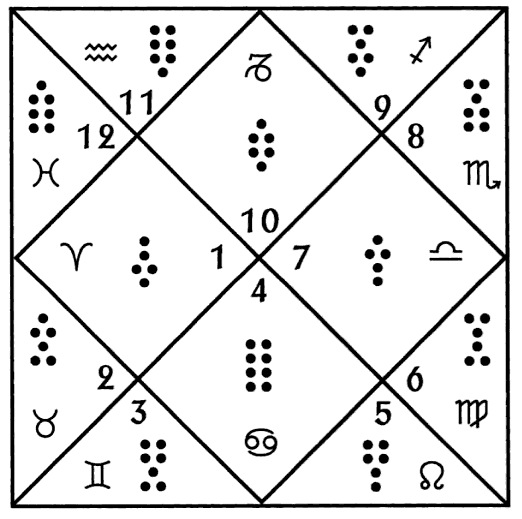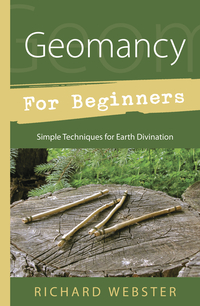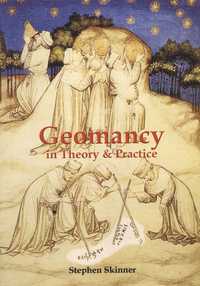Geomantic Divination
In recent days I’ve been thinking a lot about alternative forms of divination. Most of you reading this are familiar with Tarot and astrology. Some of you may also be familiar with how to use runes, palmistry or ways to “read” a crystal ball. There are, however, some lesser-known forms of divination that are every bit as powerful as the better-known methods.
One form I’ve been looking at has intrigued me since my parents took me to L.A.’s Chinatown when I was a child. It’s a sort of silly, fatalistic game consisting of a bunch of narrow wooden strips each having a number printed on it. These were all kept within in a cylindrical container. You’d think of a question and shake the container until one stick popped out. Then you’d look up the meaning of the number on the stick in a small booklet which had also been crammed into the container.
Since that time I’ve discovered that depending upon the set you obtained (and price you paid), there would be between about 40 and 100 sticks. The system has been in use in temples in China for at least 500 years, although earlier methods including the casting of lots and the I Ching are clearly ancestors of this system. It’s gone under a variety of names, but in the West it is most commonly known as “Chinese Fortune Sticks.” I’ve been interested because it’s similar to a system from India that I’ve not had much luck tracing down.
However that’s not what I want to share. The system I want to discuss today is particularly Western and is known as geomancy.
Geomancy
There are actually three things described as geomancy today. The first is a way of working with Chinese Feng Shui. The second is the study of energy paths running through the Earth. The paths are called Ley Lines, and it is said that most sacred sites are built on those lines, and the most sacred sites are where multiple lines cross.
However the form of geomancy I’m describing here is a divinatory system. I was taught that originally, people would make a series of marks in the soil (the source of the “geo-” in geomancy). You would then count the number of marks and make a single dot or two dots depending upon whether the number was odd or even.
 This process was repeated four times, giving you a figure such as the ones shown on the shield above. These were than placed on an early astrological chart (this style is still popular in parts of India). You can see an example of this in the figure below:
This process was repeated four times, giving you a figure such as the ones shown on the shield above. These were than placed on an early astrological chart (this style is still popular in parts of India). You can see an example of this in the figure below:
 From The Essential Golden Dawn by Chic Cicero and Sandra Tabatha Cicero
From The Essential Golden Dawn by Chic Cicero and Sandra Tabatha Cicero
You would then consult a book giving the meanings of the geomantic figures where they appear on the chart. Figures were then combined and interpreted in a different way, the interpretations also being culled from a book. This would lead to a final combination with still further combined figures, also interpreted with the book. It was simple and direct.
I hated it.
It seemed so mechanical. You push the stick into the ground at random, and from then on it’s just counting and looking things up in a book. There was no use of imagination. There was no elegance. There was no room for creativity in interpretation.
I have to admit, though, that because it’s so simple and direct, it’s very easy to learn. If you have never tried a divinatory system and want to learn one, or if you want to add to the divination techniques you already know, you could get Richard Webster’s Geomancy for Beginners.
 There is a small booklet on the subject written by Aleister Crowley, but it is nowhere near as thorough as Webster’s guide. You can also find information in various places including Agrippa and The Golden Dawn. However geomancy is only a small part of these books and they don’t go into real depth.
There is a small booklet on the subject written by Aleister Crowley, but it is nowhere near as thorough as Webster’s guide. You can also find information in various places including Agrippa and The Golden Dawn. However geomancy is only a small part of these books and they don’t go into real depth.
This all changed with Stephen Skinner’s amazing book, Geomancy in Theory & Practice. This is a book that will last well past your lifetime. It’s large (7″ x 10″) and beautifully hardbound, with a full-color dust jacket on the outside and an insert of seventeen black and white or color plates as well as more than fifty illustrations within. If you just want to learn the system, get Webster. If you want to know everything possible about geomancy, get Skinner.
Skinner reveals the ancient roots of this system, tracing it to origins in Africa, Madagascar and the Middle East. He traces it through the Middle Ages and the Renaissance, and finally into modern times. The he gives the precise methods of performing geomancy with examples, and shows how it relates to astrology. Finally, here is what I had missed: alternatives! With this book geomancy achieves a level of divinatory quality that makes this a very practical modern divinatory tool.
Unlike other divinatory systems that seem more oriented toward being of the Water or Earth elements, geomancy is definitely grounded in the Earth. These books by Webster and Skinner will not only make you a practical user of this system, they can make you an expert.










